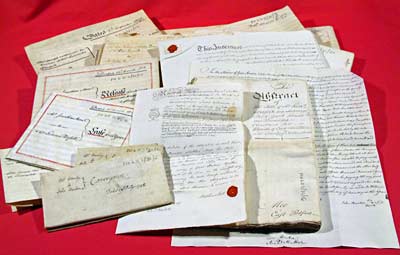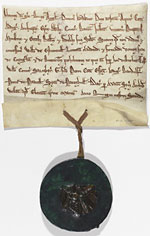What do deeds look like?
Deeds have a variety of shapes and forms. Until the middle of the nineteenth century, most deeds were hand-written on parchment - animal skins which had been specially prepared for writing. Later deeds were usually written on paper and could be typescript or printed.

Photograph of a bundle of title deeds, 1742-1817 (Ne 6 D 2/31/1-21)
Deeds vary greatly in size. Early, medieval deeds may be recorded on one membrane, measuring only a few centimetres by a few centimetres, whereas eighteenth and nineteenth century marriage settlements may be recorded on ten or more membranes, each one measuring more than a metre squared!

13th century title deed (Mi D 4650)
Another feature of deeds is that many have seals attached. Often made of red or black wax, these may be pendants - that is hanging down from the document - or may be applied - pressed directly onto the parchment or paper.
Many early deeds are written in Latin (or occasionally in French) but from 1550 onwards most are written in English.
Within archives, deeds are often found as bundles. Each bundle may range in date from decades to centuries, and represents the proof of title or ownership of a particular property. As well as the deeds themselves, bundles may contain many other ancillary papers, such as maps and plans, sale particulars, correspondence, insurance policies, probate records and so on.
To make sure their title was secure, property owners preserved vast numbers of bundles of deeds. At each conveyance of a particular property, the title deeds were handed over from vendor to purchaser. Thus, each time a property was conveyed, the bundle grew in size.
The introduction of Land Registration and the simplification of conveyancing, particularly as a result of the Law of Property Act (1925) meant that it was no longer necessary to retain large bundles of deeds. It is unusual for more than 30 years' worth of deeds to be required in order to prove title. As a result, many old deeds were transferred to archives for safekeeping. Nowadays, all land sales are recorded by the national Land Registry. 'The deeds' which are passed to the purchaser's solicitor or bank consist only of copies of the registration certificate, the results of local searches, and other legal paperwork.
Next page: What Can Deeds Tell Us?